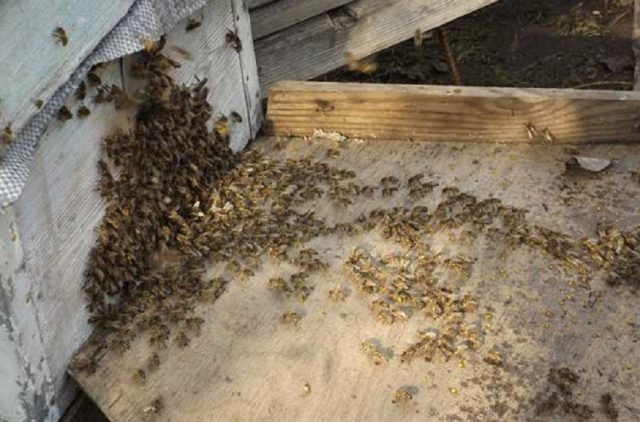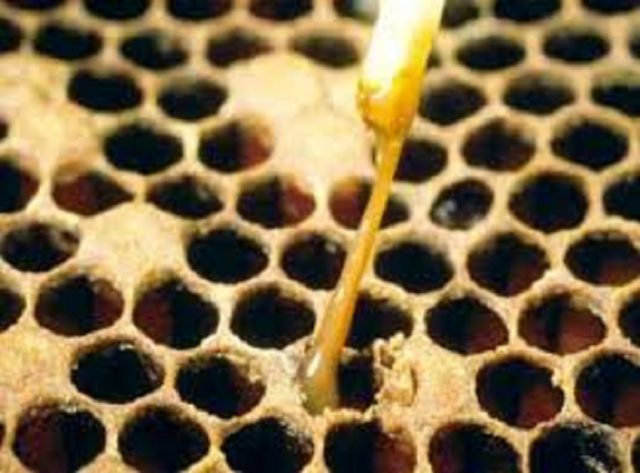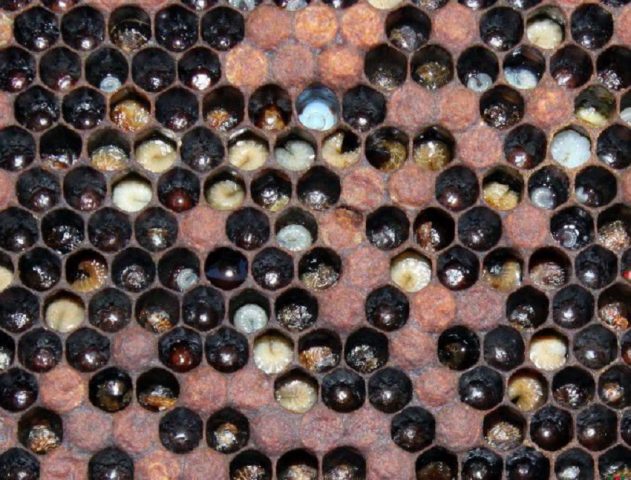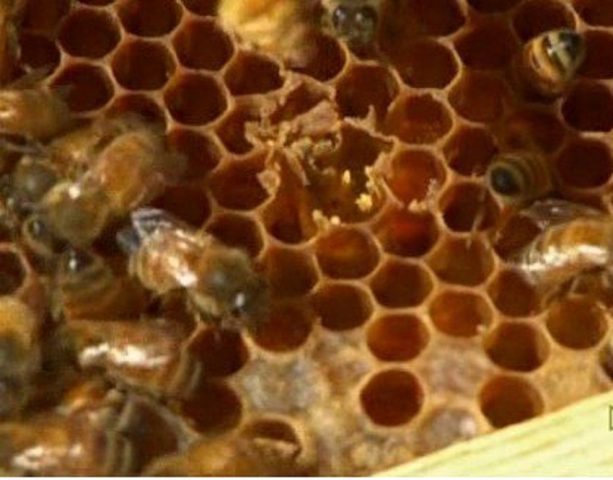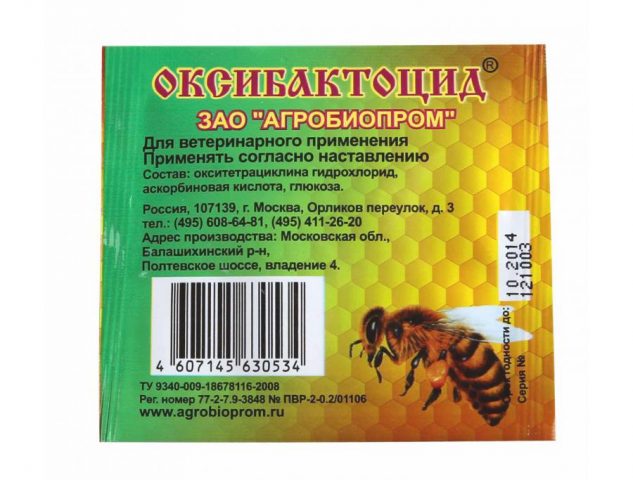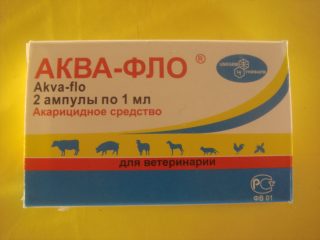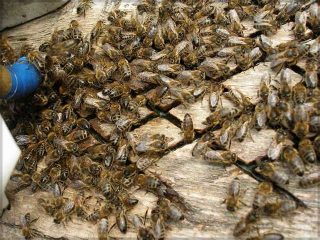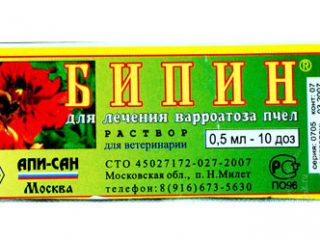Content
Beekeepers have to pay a lot of attention to the health of bee colonies. Among the list of the most dangerous diseases, rotten diseases occupy a special place. They have a detrimental effect on the brood, negatively affect the health of the whole family, and reduce the quality of honey. How to identify foulbrood in bees in time and how to cure insects will be described later.
General description of the disease
Foulbrood is a disease of the brood, although its effect extends to the entire family. The disease affects worker bees, queen bees, prepupae. As soon as the brood becomes infected, beekeepers will notice holes in the lids. After the death of the larvae, a specific smell of rot is felt with an admixture of the smell of wood glue.
A decrease in productivity is not included in the beekeeper's plans, so you should familiarize yourself with the description of the problem and methods of getting rid of it in advance. Bee foulbrood is an infectious disease caused by the bacterium Bacillus larvae. Spores of pathogenic microorganisms are the source of the disease in bees. The activity of bacteria lasts for many years, their viability in the particles of dead larvae is up to 30 years.
Spores of bacteria enter the intestine of the larva if it eats contaminated feed. The carriers of the infection can also be the breadwinner bees, in which the spores remain on the mouth organs or paws. The incubation period lasts from 2 to 7 days. The very first 3 days the bee larva is protected from foulbrood by milk, its bactericidal properties. Then the spores cannot develop due to the high concentration of sugars in the intestine of the larva. In a sealed cell, the bee larva lives off the accumulated nutrients. When the sugar content drops to 2.5%, the active development of pathogen spores begins. This happens from 10 to 16 days.
The death of the larva from foulbrood occurs when it enters the prepupal stage and the cell is sealed. Then the color of the larva changes to brown, a rotting smell appears, the cell lid goes down following the head. If you pull a mass out of the cell with a match, it resembles thin long threads.
The treatment of bee foulbrood is very difficult. This is due to the fact that the pathogen remains in hives, soil, bee sushi, in inventory, honey reserves. Therefore, beekeepers cannot relax. Even after the family is healed, the infection suddenly flares up again and requires new efforts to fight.
Varieties
The disease is divided into varieties according to the decreasing degree of danger of infection of the larvae:
- American foulbrood... Another name is closed brood foulbrood. The most dangerous species for bees.
- European foulbrood... This is an ailment of open brood. The degree of danger is slightly reduced compared to the American one.
- Paragnite... The second name is false foulbrood. A less dangerous type of bacterial infection of bees.
It should be said that the division is a bit symbolic. It is necessary to treat bees from foulbrood in all cases very efficiently.
What is the danger of the disease
The main danger lies in the possibility of spreading the infection over a long distance and its difficult cure. The foulbrood easily moves even to neighboring apiaries, infecting new bee colonies.The peak of infestation of bees is in July, this month is the most comfortable for spores with its temperature regime. Bacteria proliferate actively at + 37 ° C.
This means that the disease has already spread to part of the brood. The bees remove the caps, but they cannot completely remove the contents of the cell. Therefore, the next bookmark is made in the neighboring ones. The combs have a variegated appearance typical of the affected brood.
American foulbrood
According to the degree of danger, it ranks first among the varieties of the disease. It is called malignant.
The loss of family productivity is about 80%, complete extinction occurs within 2 years. Paenibacillus larvae, the American foulbrood bacteria, is most active in late spring and summer. In this case, the infected larvae of bees die in closed cells. Foulbrood can infect any kind of bees, but it is harmless to humans and animals, which often serve as carriers of the pathogen. Spores of American foulbrood bees are resistant to adverse factors and influences, they are able to live on plants, in soil, on beekeeper's tools for more than 7 years. On the corpses of dead larvae, they remain viable for about 30 years.
Infection of bees is possible through an infected tool or honey for feeding, through insects - beetles, moths, ticks.
The causative agent of foulbrood affects the larvae of bees aged 5-6 days. After defeat, they die, rot and turn into a viscous mass with a specific smell that resembles wood glue. The rapid spread of the disease destroys a large number of larvae. Without sufficient replenishment, the family weakens, this can lead to the death of an entire bee family.
It is difficult to clear the cell from the putrefactive mass, therefore the uterus refuses to stay in such combs.
European foulbrood
The second type of disease. European foulbrood differs from American foulbrood in that larvae of open (unsealed) brood at the age of 3-4 days are exposed to it. Sealed brood can also be affected if the infection is severe.
The causative agent was studied in Europe, so this type of foulbrood is called European. Affected individuals lose segmentation (segmentation), change color to straw yellow. Then a sour smell appears, the corpse acquires a viscous consistency, then dries up. It is easier to remove the dead larva than with the defeat of the American type of infection. European foulbrood can affect uterine or drone larvae. The peak of the spread of the disease occurs in the spring and summer. The percentage of morbidity during the period of honey collection is slightly reduced. Bees are more active in cleansing the cells.
It is possible to accurately determine the type of bee disease only with the help of laboratory research, where part of the foundation with sick or dead larvae is transferred.
The level of danger of infection with foulbrood increases significantly if the rules for caring for bees and evidence are not followed:
- presence of dirt;
- weak insulation;
- old honeycombs in which pest spores remain.
The causative agents of European foulbrood are several types of bacteria:
- streptococcal pluton;
- streptococcal bee bacteria;
- bacillus alveean;
- the bacterium is plutonic.
They are resistant to different conditions, so they remain vital for a very long time. They die in honey after 3 hours, due to the strong antibacterial properties of the product. Also destroyed by phenolic substances.
Paragnite
Less dangerous species. The parasite affects the older larvae. Most often, the lesion occurs in high mountain areas with a cold climate.
This variety differs from others in the state of the dead larvae. They:
- are odorless;
- dry quickly;
- the crusts are not intensely colored;
- corpses are easy to remove.
Brood death occurs in a sealed cell, much less often in an open one. There are several main symptoms of bee disease:
- in diseased pupae, motor activity increases;
- they assume an unnatural position;
- the sealed lids turn dark and bulge;
- a cone-shaped depression is seen in the center of the bulge;
- there is no hole inherent in American foulbrood;
- dried pupae are easily removed from the cell.
To make a correct diagnosis, pay attention to the age of the affected larvae, smell and consistency. The final answer can be obtained only after laboratory tests.
How to treat bees for foulbrood
Putrid diseases in bees cannot be cured without resettlement of families. For this, disinfected hives with artificial waxes are used. Such an event is called a ferry. For the treatment of American foulbrood, bees are distilled twice, but sequentially. There are two procedures for driving - with and without fasting:
- With fasting... First, it is necessary to shake off all the bees from the frames into an empty hive, close the entrances with a lattice, and transfer it to a dark room. The purpose of fasting is the complete consumption of honey in the goiter of insects, which can be saturated with bacterial spores. The bees at this time stray into a lump and hang under the lid. As soon as insects from hunger begin to crumble to the floor, they are moved to a clean hive. It should already be equipped with frames. The new uterus is given to the family in a cage.
- No starvation... The hive is removed, the bees are shaken off on paper before the new one. In this case, the uterus is removed from the family. If this colony has enough healthy brood, it is moved to a new one. The holes are closed, providing the bees with a sufficient volume of water and medicinal food. A week later, the mother liquors are broken out. As soon as the brood emerges, the colony is distilled into a disinfected hive and receives a fetal uterus. The bees are given medicated syrup.
The wax is boiled for 2.5 hours, then processed into wax.
Straw and wax from infected apiaries must be labeled as “foul”.
The brood remaining after ferrying is placed in closed evidence for the incubation period, then it goes to the formation of a new bee colony.
Further treatment for foulbrood in bees involves disinfecting areas under the evidence, calcining the soil with a blowtorch or using a fireplace. The inner surface of the hives is disinfected by firing, cleaned and washed.
The apiary is closed for quarantine, which is removed the next year after the ferry, if no re-manifestation of the disease is recorded.
If single families are affected by American foulbrood, it is recommended to destroy them.
Treating bees for European or American foulbrood is effective if no new brood is set. That is why the queen is removed from the bee colony.
Preparations for the treatment of bees from foulbrood
The optimal time for treating bee colonies from foulbrood is June. Then sick insects keep up with healthy ones and take part in the main bribe. If the bee colony is strongly affected by foulbrood, then they get rid of it. Insects are destroyed with formaldehyde, those that crumble are burned. In the case of a constant manifestation of rotten diseases, medicinal compositions are also given to healthy families.
The main groups of drugs that are used to treat foulbrood in bees are antibiotics and sulfonamides, such as sulfanthrol or sodium norsulfazole.
They are mixed with sugar syrup. Doses of drugs in the treatment of foulbrood bees are calculated based on the number of families that need help. The calculation is based on the volume of sugar syrup. One street requires 100-150 g, when spraying from a spray bottle - 100-150 g per frame. Then a medicinal preparation is added to 1 liter of syrup in a dosage according to the instructions.
Antibiotic treatment for foulbrood in bees
An effective way to combat foulbrood of bees in an apiary. First, the amount of syrup is calculated, then an antibiotic is added to it and therapeutic measures are carried out. When treating foulbrood in bees with antibiotics, drugs must be alternated. Effective drugs are:
- Ampiox;
- Oxytetracycline;
- Rifampicin;
- Neomycin;
- Biomycin;
- Erythromycin.
Sulfonamides are also used - drugs with antimicrobial action.
A very good result against foulbrood is obtained by combining antibiotics with sulfonamides. For example, 2 g of norsulfazole is combined with 1 g of ampiox, diluted in 1 liter of sugar syrup and consumed for 5 frames. The number of treatment procedures for bees is 3-4 times. Regularity once a week. For healthy families, the number of procedures is reduced up to 2 times. The syrup is made from sugar and water in a 1: 1 ratio.
One street requires 500,000 biomycin. In 1 g million units, for a family of 12 frames, you need to take 500 mg. Veterinarians say that it is advisable to increase the dose and take 1 g. This is due to the fact that an insufficient amount of antibiotic will be useless. Tetracyclines, Neomycin, Oxytetracycline and Erythromycin are taken in the calculation of 400,000 units, norsulfazol sodium 1 g, sulfanthrol 2 g.
An effective drug in the treatment of foulbrood is Bacteriophage. Top dressing is prepared during the day, and bees are given in the evening. This is less annoying for insects.
After the course of treatment, the bee family is examined to make sure that the measures taken are effective.
On sale there is a powder Oxybacticide, the basis of which is oxytetracycline, and glucose and ascorbic acid act as additional components. In addition to powder, the product is available in the form of strips. It is used for the treatment and prevention of foulbrood diseases in bees. Healing syrup is prepared from 5 g of powder and a quarter of a glass of water. Dose for 10 liters of syrup. One frame needs 100 ml of solution.
Ways of using drugs:
- dusting with medicinal powder from a mixture of the drug and sugar;
- spraying;
- kandy.
Methods for treating foulbrood in bees with folk remedies
Folk methods in the fight against the disease are considered ineffective. Substitution of drugs can only be distillation with fasting. However, modern beekeepers successfully use celandine treatment for foulbrood in bees. After the end of the last pumping of honey, a preventive treatment with an infusion of the plant is performed. An infusion of celandine is prepared from 100 g of fresh herbs and 2 liters of boiling water. The mixture is brewed and infused for 30 minutes. Pour the product into a spray bottle, treat not only the bees, but also the working surfaces of the hive.
Processing of hives and inventory
When foulbrood is found, bees are immediately transplanted into a clean hive with a colony. The old dwelling and equipment are disinfected indoors. Apply a solution of hydrogen peroxide (3%) + ammonia, chloramine solution, Farmayod, Domestos.
- The honey extractor is moistened with a product, left for 3-4 hours, then washed off.
- The scrims and all textile items are boiled in a solution of lye for 30 minutes.
- The hives are burned with a blowtorch, after having cleaned them of wax. The second option is to cover with one of the solutions listed above several times with an interval of 1 hour.
- Burn or disinfect metal objects in one of the solutions.
- Wooden frames are boiled in caustic soda solution for 15 minutes.
- The earth under the evidence is dug up with the addition of lime.
- The honeycombs with parts of the dead pupae are reheated, the frames are burned, the wax is used only for technical purposes.
- Honey is eaten, but not given to bees to feed.
With a strong infection with foulbrood, families are disposed of.
A set of preventive measures
Treating families is labor intensive, so prevention is the focus. Among the effective preventive measures against foulbrood should be highlighted:
- Careful examination when purchasing queens or bee layers.
- Annual disinfection of equipment, hives, storage rooms.
- Cleaning the territory of the apiary from debris and dirt.
- Annual renewal of 1/3 of the number of cells. Do not use old and black ones.
- Maintaining large family sizes.
- Exclusion of contact of bees with quarantined colonies.
Many beekeepers use prophylactic medicated feedings with antibiotics.
Conclusion
Foulbrood in bees causes a lot of trouble for beekeepers and reduces the productivity of families. To avoid this, you need to carefully carry out preventive measures. In case of infection, follow the instructions of the veterinarian exactly.
